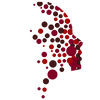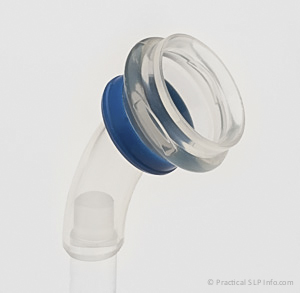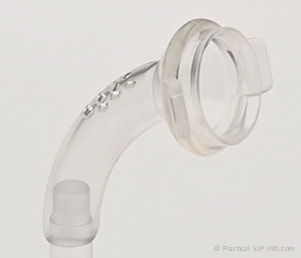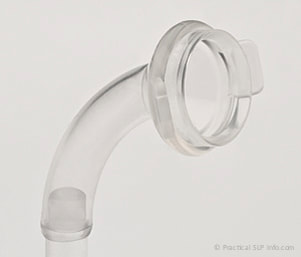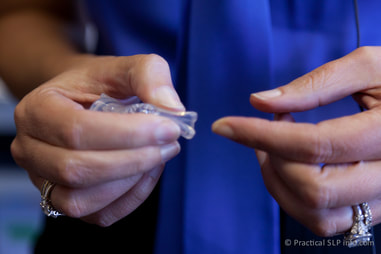A Larytube is a pliable silicone tube, designed to maintain an airway of a laryngectomy. It has a curvature consistent with the curvature of the trachea following a laryngectomy. Larytubes are designed to be used with an HME cassette and can be used with either an adhesive housing, or ties/clips. Larytubes can also be worn with a TEP, allowing you to speak normally. The SLP staff will determine the appropriate tube for you to use, if/when necessary.
In this practice, a Larytube is used to ensure there is adequate support of the stoma as it heals following surgery. Primarily, it helps to keep the airway open in the presence of any post-operative swelling that may exist. During your first SLP visit as an outpatient, the SLP staff will assess the overall condition of your stoma and will help to wean you from the tube. In most cases, a Larytube is not worn following post-operative recovery. There are special circumstances, however, when a Larytube may be indicated even after you are fully recovered from surgery. It is VERY IMPORTANT that you use the Larytube as directed by the SLP staff if it determined you should wear one.
Inserting a Larytube
A Larytube is most easily passed into the trachea when well lubricated. It is important to ONLY USE A WATER SOLUABLE LUBRICANT, such as KY Jelly. NEVER use Vaseline or any other petroleum or oil-based, lubricant as this will damage the tube.
Once lubricated, ensure the tube is properly aligned with the trachea. Notice there is a curvature to the Larytube and it is therefor very important the tube be inserted with the proper alignment to ensure there is no trauma to the tracheal wall. The number, printed at the opening to the Larytube should be in a six o’clock position. Once lubricated and aligned, the tube can be easily inserted through the stoma. If needed, the tube can be bent at the tip, narrowing somewhat to allow for easier passage through the stoma. The SLP staff can demonstrate this technique if necessary. See photo of this example.
It is important the tube be fully inserted into the trachea, with the opening to the tube firmly against the tracheostoma. If using the tube with an adhesive, be sure the blue ring of the tube is full inserted into the ring of the housing.
|
Whether using ties, clips or an adhesive housing, it is important to ensure the Larytube is sufficiently secured. This will prevent it from pistoning within the trachea or accidentally dislodging.
Even if you are instructed to wear your Larytube all day, 24/7, it is important that the tube be properly cleaned. This should be done twice a day, morning and evening, and more often as needed to ensure an adequate airway and that you are breathing comfortably. A brush can be used with clean water to clear secretions from the inner wall of the tube. Often times, a small, soft cloth can be pulled through the tube to assist with cleaning. Once any mucous and debris have been cleared from the tube. Rinse thoroughly with water and allow to air dry. According to the manufacturer, the tube may be boiled in water for 5 minutes. Always allow the tube to cool before inserting. NOTE: If you are using a Larytube and heading into surgery for any reason, give the Larytube to a family member to hold. Hospital staff frequently discard these and throw them away. |
|
